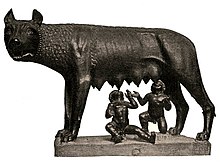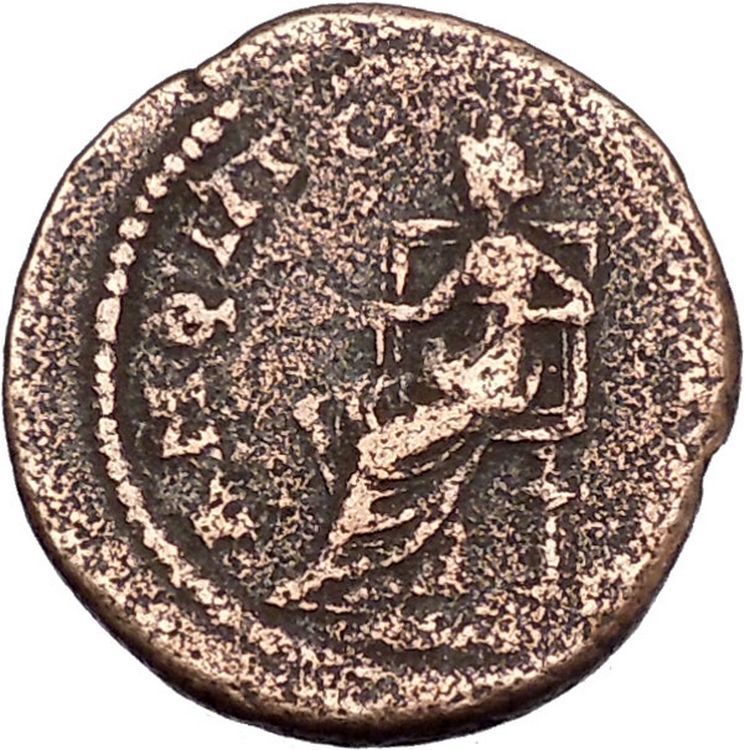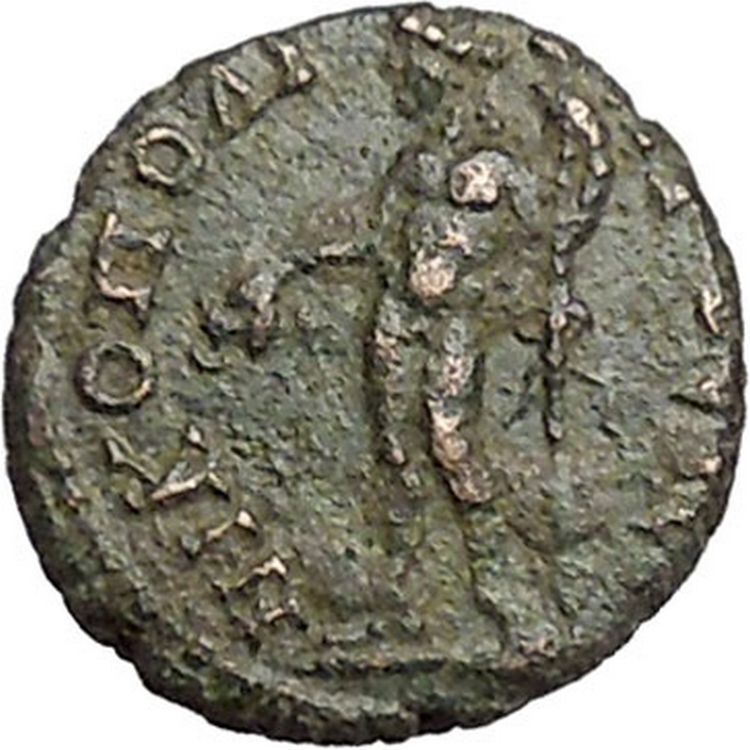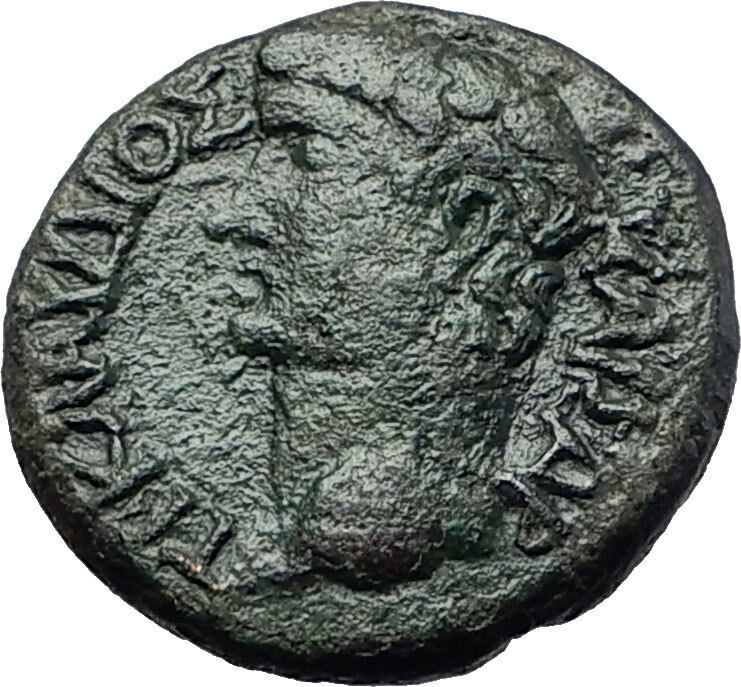|
Greek city of Alexandria Troas in Troas Pseudo-Autonomous Issue
Time of Gallienus (260-268 A.D. ).
Bronze 19mm (4.49 grams) Struck circa 260-268 A.D.
Reference: Bellinger, Troy A 468
ALEX TRO. Turreted and draped bust of Tyche right; vexillum to left.
COL AVG TROAD. Statue of Apollo Smintheus right, with bow and patera.
A coastal city situated south-west of Ilion, it was founded circa 310 B.C. by Antigonos and originally bore the name Antigoneia. A decade later Lysimachos renamed the place Alexandreia.
You are bidding on the exact item pictured, provided with a Certificate of Authenticity and Lifetime Guarantee of Authenticity.
 Romulus and Remus are Rome’s twin founders in its traditional foundation myth. They are descendants of the Trojan prince and refugee Aeneas, and are fathered by the god Mars or the demi-god Hercules on a royal Vestal Virgin, Rhea Silvia, whose uncle exposes them to die in the wild. They are found by a she-wolf who suckles and cares for them. The twins are eventually restored to their regal birthright, acquire many followers and decide to found a new city. Romulus and Remus are Rome’s twin founders in its traditional foundation myth. They are descendants of the Trojan prince and refugee Aeneas, and are fathered by the god Mars or the demi-god Hercules on a royal Vestal Virgin, Rhea Silvia, whose uncle exposes them to die in the wild. They are found by a she-wolf who suckles and cares for them. The twins are eventually restored to their regal birthright, acquire many followers and decide to found a new city.
Romulus wishes to build the new city on the Palatine Hill; Remus prefers the Aventine Hill. They agree to determine the site through augury. Romulus appears to receive the more favourable signs but each claims the results in his favour. In the disputes that follow, Remus is killed. Ovid has Romulus invent the festival of Lemuria to appease Remus’ resentful ghost. Romulus names the new city Rome, after himself, and goes on to create the Roman Legions and the Roman Senate. He adds citizens to his new city by abducting the women of the neighboring Sabine tribes, which results in the combination of Sabines and Romans as one Roman people. Rome rapidly expands to become a dominant force, due to divine favour and the inspired administrative, military and political leadership of Romulus. In later life Romulus becomes increasingly autocratic, disappears in mysterious circumstances and is deified as the god Quirinus, the divine persona of the Roman people.
The legend of Romulus and Remus encapsulates Rome’s ideas of itself, its origins, moral values and purpose: it has also been described as one of the most problematic of all foundation myths. Romulus’ name is thought to be a back-formation from the name Rome; Remus’ is a matter for ancient and modern speculation. The main sources for the legend approach it as history and offer an implausibly exact chronology: Roman historians dated the city’s foundation variously from 758 to 728 BC. Plutarch says Romulus was fifty-three at his death; which reckoning gives the twins’ birth year as c. 771 BC. Possible historical bases for the broad mythological narrative remain unclear and much disputed. Romulus and Remus are eminent among the feral children of ancient mythography.
Alexandria Troas (“Alexandria of the Troad”, modern Turkish: Eski Stambul) is an ancient Greek city situated on the Aegean Sea near the northern tip of Turkey’s western coast, a little south of Tenedos (modern Bozcaada). It is located in the modern Turkish province of Çanakkale. The site sprawls over an estimated 400 hectares (1,000 acres); among the few structures still extant today are a ruined bath and gymnasium complex and a recently uncovered stadium.
Hellenistic
According to Strabo, this site was first called Sigeia; around 306 BC Antigonus refounded the city as the much-expanded Antigonia Troas by settling the people of five other towns in Sigeia, including the once influential city of Neandria. Its name was changed by Lysimachus to Alexandria Troas, in memory of Alexander III of Macedon (Pliny merely states that the name changed from Antigonia to Alexandria). As the chief port of north-west Asia Minor, the place prospered greatly in Roman times, becoming a “free and autonomous city” as early as 188 BC,[3] and the existing remains sufficiently attest its former importance. In its heyday, the city may have had a population of about 100,000. Strabo mentions that a Roman colony was created at the location in the reign of Augustus, named Colonia Alexandria Augusta Troas (called simply Troas during this period). Augustus, Hadrian and the rich grammarian Herodes Atticus contributed greatly to its embellishment; the aqueduct still preserved is due to the latter. Constantine considered making Troas the capital of the Roman Empire.
Roman
In Roman times, it was a significant port for travelling between Anatolia and Europe. Paul of Tarsus sailed for Europe for the first time from Alexandria Troas and returned there from Europe (it was there that the episode of the raising of Eutychus later occurred). Ignatius of Antioch also paused at this city before continuing to his martyrdom at Rome.
Byzantine
Several of its later bishops are known: Marinus in 325; Niconius in 344; Sylvanus at the beginning of the 5th century; Pionius in 451; Leo in 787; Peter, friend of the Patriarch Ignatius, and adversary to Michael, in the ninth century. In the 10th century Troas is given as a suffragan of Cyzicus and distinct from the famous Troy (Heinrich Gelzer, Ungedruckte … Texte der Notitiae episcopatuum, 552; Georgii Cyprii descriptio orbis romani, 64); it is not known when the city was destroyed and the diocese disappeared. The city remains a titular see of the Roman Catholic Church, Troadensis; the seat is vacant following the resignation of the last bishop in 1971.
Troas is also a titular see of the Orthodox Church under the Ecumenical Patriarchate. The most recent hierarch, His Grace Bishop Savas (Zembillas) of Troas, served 2002-2011. He is now Metropolitan Savas (Zembillas) of Pittsburgh in the Greek Orthodox Archdiocese of America.
Ottoman
Karasid Turkomans settled in the area of the Troad in the 14th century. Their beylik was conquered by the Ottomans in 1336. The ruins of Alexandria Troas came to be known among the Turks as Eski Stambul, the “Old City”. The site’s stones were much plundered for building material (for example Mehmed IV took columns to adorn his Yeni Valide Mosque in Istanbul). As of the mid-18th century the site served as “a lurking place for bandetti”.
Modern
By 1911 the site had been overgrown with vallonea oaks and much plundered, but the circuit of the old walls could still be traced, and in several places they were fairly well preserved. They had a circumference of about ten kilometres, and were fortified with towers at regular intervals. Remains of an ancient bath and gymnasium complex can be found within this area; this building is locally known as Bal Saray (Honey Palace) and was originally endowed by Herodes Atticus in the year 135. Trajan built an aqueduct which can still be traced. The harbour had two large basins, now almost choked with sand. It is the subject of a recent study by German archaeologists who are digging and surveying at the site. Their excavation has uncovered the remains of a large stadium dating to about 100 BC.
|





 Romulus and Remus are Rome’s twin founders in its traditional foundation myth. They are descendants of the Trojan prince and refugee Aeneas, and are fathered by the god Mars or the demi-god Hercules on a royal Vestal Virgin, Rhea Silvia, whose uncle exposes them to die in the wild. They are found by a she-wolf who suckles and cares for them. The twins are eventually restored to their regal birthright, acquire many followers and decide to found a new city.
Romulus and Remus are Rome’s twin founders in its traditional foundation myth. They are descendants of the Trojan prince and refugee Aeneas, and are fathered by the god Mars or the demi-god Hercules on a royal Vestal Virgin, Rhea Silvia, whose uncle exposes them to die in the wild. They are found by a she-wolf who suckles and cares for them. The twins are eventually restored to their regal birthright, acquire many followers and decide to found a new city.




